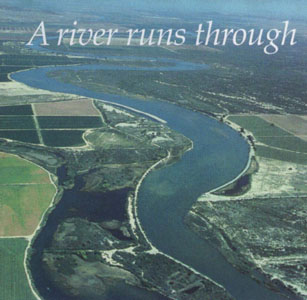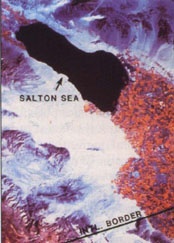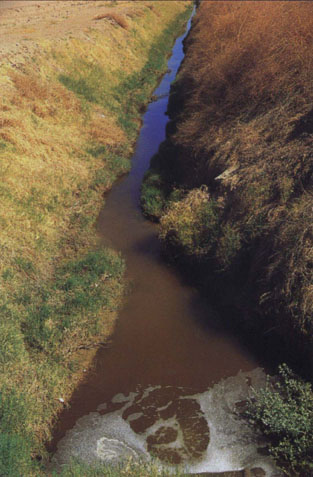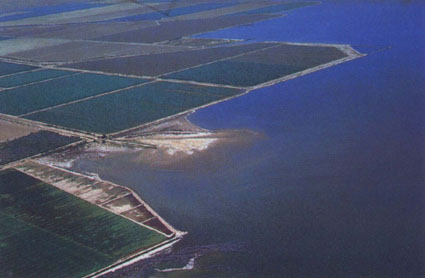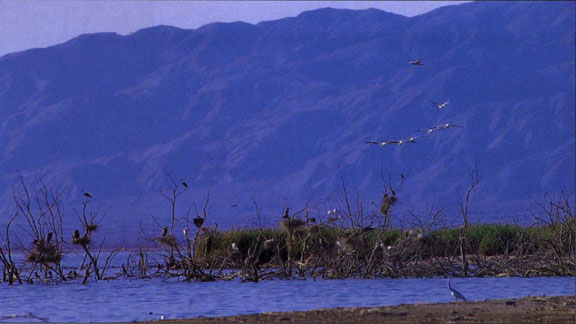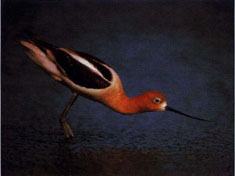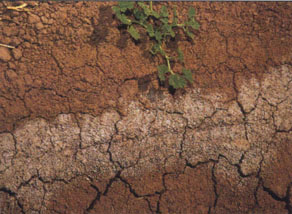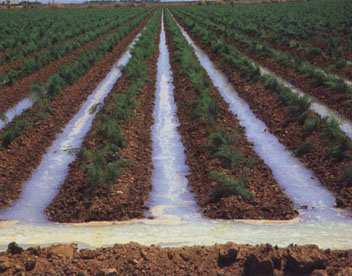All Issues
A river runs through desert agriculture
Publication Information
California Agriculture 51(3):6-10.
Published May 01, 1997
PDF | Citation | Permissions
Full text
Above, the lower Colorado River (shown near Blythe) supplies irrigation water to highly productive agricultural areas in the Bard, Coachella, Imperial and Palo Verde valleys.
Right, a Landsat image shows fields in the Imperial Valley extending to the edge of the Salton Sea, which serves as a drainage basin for agricultural runoff.
Agriculture in California's southern desert region is almost entirely dependent on water diverted from the Colorado River. The Colorado also supplies much of Southern California's drinking water, as well as providing water to six other states and Mexico. Because other states were slow to develop the infrastructure or the demand to use their entire allotments of Colorado River water, California has grown accustomed to using the surplus. This situation is rapidly changing, however, and California is being pressured to live within its legal entitlement. At the same time, growing urban populations are increasing the demand for water within the state.
One result has been a major emphasis on water conservation programs and water transfers between agricultural areas and cities. Growers in the Imperial Valley, who have built a billion-dollar agricultural economy on abundant Colorado River water, are now contemplating how to grow crops in the desert with less water.
“There is great demand for water in Los Angeles and San Diego, and anything we do here in the Valley to conserve water makes more available for urban use, so there is definitely pressure to conserve,” says Imperial Valley farm advisor Khaled Bali.
Problems caused by the large amounts of agricultural drainage water entering the Salton Sea provide further incentives for changing water management practices in the southern desert (see sidebar). Numerous lawsuits have resulted from flooding of privately owned land bordering the Sea, which has no outlet.
Law of the River
The Colorado River's waters are allocated among seven states and Mexico according to a complicated set of compacts, court decisions and treaties. The so-called “Law of the River” allocates 7.5 million acre-feet per year to the four upper basin states (Colorado, New Mexico, Utah and Wyoming), another 7.5 million acre-feet to the three lower basin states (Arizona, California and Nevada) and 1.5 million acrefeet to Mexico. Unfortunately, the average annual flow of the river is only 15 million acre-feet, perhaps less according to some experts.
“The Colorado River is over-allocated because the entitlements were set on the basis of high flows decades ago,” says Richard Howitt, UC Davis professor of agricultural economics.
The river has already been so thoroughly appropriated for human use that in most years the riverbed runs dry miles above its parched delta in the Gulf of California. While the upper basin states do not yet use all of their apportioned share of the river, the lower basin has exceeded its annual allocation of 7.5 million acre-feet on two occasions. Under the Law of the River, the upper basin may not withhold surplus water needed in the lower basin for current beneficial use.
California's legal entitlement is 4.4 million acre-feet annually, an amount the state usually exceeds by about 20%. As other states begin to claim their allotments, California is feeling the pinch and urban water districts are thirstily eyeing the 3.85 million acre-feet, 87% of the state's entitlement of Colorado River water, that is allocated for agricultural use.
The Imperial Valley alone receives an average of 2.9 million acre-feet of Colorado River water annually through the 82-mile-long All American Canal. The rest of California's agricultural allotment is used in the Bard, Palo Verde and Coachella valleys.
Water transfer
In 1980, a farmer whose land was being flooded by the Salton Sea sued the Imperial Irrigation District (IID), charging it with inefficient and wasteful management of irrigation water. The State Water Resources Control Board eventually ordered the district to implement water conservation measures. In 1989, IID began a major conservation program funded by a water transfer agreement with the Metropolitan Water District (MWD) of Southern California, which provides water to cities on the coastal plain from Ventura to the Mexican border. Under the agreement, MWD is paying for water conservation projects in the Imperial Valley in exchange for the conserved water, projected to be 106,000 acre-feet per year over 35 years. IID is currently just shy of this goal, saving about 97,000 acre-feet annually as a result of measures implemented under the agreement, according to spokesperson Patricia Brock.
So far, IID's water conservation program has relied primarily on improvements in the delivery system, such as lining of canals to prevent losses due to seepage. Other improvements, such as regulating reservoirs, lateral interceptors and system automation, have added flexibility to the delivery system, allowing growers, for example, to turn water back and hold it in a reservoir for later use. MWD funds also paid for on-farm water conservation measures, such as tailwater recovery systems designed to capture and reuse surface runoff.
Salton Sea keeps getting saltier
An avocet, one of thousands of migrating shore-birds that use the Salton Sea, feeds in the shallows.
The Salton Trough was once a dry depression more than 200 feet below sea level, separated from the Gulf of California by the broad delta of the Colorado River. It became the Salton Sea in 1905, when the headgates of an irrigation canal collapsed and the entire Colorado River flooded through the Imperial Valley. It took 2 years to control the floodwaters, by which time the Salton Sea had become one of the largest inland bodies of water west of the Rocky Mountains.
The sea is a sink for surrounding rivers and agricultural runoff, but it has no outlet and flooding around the perimeter has become a serious problem. In addition, the Salton Sea is becoming increasingly salty due to evaporative concentration. It is now more than 30% saltier than the Pacific Ocean. If nothing is done to check salinization, the Salton Sea will eventually become like the Great Salt Lake in Utah. The fish (primarily tilapia, an introduced African species) will die and the bird populations and other wildlife that now use the area will change significantly.
Agriculture is only one of a variety of factors contributing to these problems. The Salton Sea receives inflow from Mexico and the Imperial Valley through the New River and the Alamo River, from the Coachella Valley through the Whitewater River, and from local mountains through San Felipe Creek. In addition to fresh water, these channels carry agricultural runoff containing salts and residual pesticides and fertilizer. The New River also carries industrial waste and untreated and partially treated sewage from Mexicali, Mexico, a city of 4 million people.
Deteriorating conditions in the Salton Sea have already substantially reduced its use for recreational activities, such as boating, water skiing and fishing. During the warm summer months, algae proliferate in the water, then die and decompose, giving off an unpleasant odor. The algal blooms are stimulated by nutrients contained in agricultural runoff and in sewage flowing into the sea from Mexico.
Despite salinity and pollution problems, the Salton Sea provides critical habitat for waterfowl and other migratory birds on the Pacific Flyway. The Salton Sea National Wildlife Refuge was established at its southern end in 1930. The area attracts more than one million migrating birds annually, provides wintering habitat for ducks and geese, and harbors several endangered species.
The Imperial Irrigation District (IID), faced with lawsuits from landowners whose property was being flooded by the rising Salton Sea, has been encouraging growers in the Imperial Valley to reduce surface runoff by using tailwater recovery systems. These and other water conservation measures may help control the level of the Salton Sea, but they will only exacerbate the salinity problem. Tailwater serves to dilute the drainage water, which flows out of fields after percolating through the soil and contains elevated concentrations of salts and possibly selenium.
Selenium is not yet a serious problem in the Salton Sea area, as it is in the San Joaquin Valley. The highest concentrations occur in the Alamo River and are right around the level that can cause reproductive problems in birds, but no evidence of such problems has been seen.
There have been several incidents at the Salton Sea in which thousands of birds have died, including an outbreak of avian botulism in 1996 that killed more than 14,000 birds. Other bird die-offs remain unexplained. The botulism outbreaks appear to be related to bacterial infections in fish. Outbreaks of fish diseases are often caused by environmental stresses, including pollution, overcrowding, and high temperatures and salt levels, all of which are present in the Salton Sea.
The Salton Sea Authority, which includes representatives from the irrigation districts, Imperial and Riverside counties, the U.S. Fish and Wildlife Service (USFWS) and other stakeholders, has proposed a diking operation to manage the salinity and water level problems. Evaporation ponds would be used to concentrate the salts in one area of the sea. But according to USFWS wildlife biologist Ken Sturm, evaporation ponds have a poor track record in terms of environmental impacts. Birds would have to be attracted away from the evaporation ponds to prevent their exposure to high concentrations of selenium and other pollutants.
Other proposals include building a pipeline to the Gulf of California and circulating water from the Sea of Cortez through the Salton Sea. To do this would be extremely expensive, require negotiating a treaty with Mexico, and involve sending waste water into the ecologically sensitive Gulf of California.
“The problem is that an enormous amount of salt goes into the Salton Sea every day, and it has to go somewhere, either in the basin or to the Sea of Cortez,” says Chris Amrhein, associate professor of soil and environmental sciences at UC Riverside.
One possibility Amrhein and others are investigating is whether agricultural waste water can be used to create new wetlands, which would serve both as wildlife habitat and as a biological filter to partially treat the waste water.
Other on-farm conservation measures, such as drip irrigation and sprinkler irrigation, have not been widely implemented in the Imperial Valley. Surface irrigation continues to be used on 95% of the irrigated land, according to Bali.
Above, evaporation wicks salts to the soil surface. Water conservation efforts must be carefully balanced against the need to prevent soil salinity problems.
Soil salinity
Water conservation efforts must be carefully balanced against the need to prevent soil salinity problems. The relatively high salt content of Colorado River water (700 to 850 parts per million) combined with high rates of evapotranspiration in the desert can lead to a rapid buildup of salts in the root zone, resulting in serious productivity losses. Ample water supplies have enabled growers to leach salts out of the soil, and tiles installed beneath most fields drain off the excess water, which then flows into the Salton Sea.
Drip irrigation, however, applies only as much water as the crop needs to grow. To reduce the accumulation of salts in drip-irrigated fields, excess water must be periodically applied through surface or sprinkler irrigation. Drip irrigation is used on less than 5% of the irrigated land in the Imperial Valley, mostly on vegetable crops and citrus. In the Coachella Valley, where drip irrigation is more widespread, growers began using groundwater when they implemented drip irrigation because the silt in unfiltered Colorado River water clogs drip delivery systems. The Coachella Valley Water District (CVWD) currently uses around 330,000 acre-feet of Colorado River water per year, down from as much as 475,000 acre-feet in past years. Now, however, well water levels in the Coachella Valley are rapidly declining and CVWD wants to increase its use of Colorado River water to counteract the groundwater overdraft.
Conservation measures that focus on surface runoff or tailwater recovery may also pose soil salinity problems. According to Bali, about 17% of the water applied in surface irrigation typically runs off without soaking into the soil. This surface runoff picks up salts that have accumulated on the soil surface, resulting in elevated salt concentrations in the tailwater. For this reason, recycled tailwater must be mixed with fresh irrigation water before it is reapplied to fields. An alternative to tailwater recovery involves managing the application of surface irrigation more precisely. Bali and other UC researchers are developing a management method for reducing runoff from alfalfa and sudangrass fields through careful timing of water applications.
Tailwater from agricultural fields flows into the Salton Sea, where it helps dilute the high salinity but contributes to flooding problems.
New proposals
A new water transfer proposal may make on-farm conservation measures necessary on a massive scale in the Imperial Valley. In 1996, IID began negotiating with the San Diego County Water Authority (SDCWA) to transfer at least 200,000 acre-feet annually. The details of the proposal have not been worked out yet, but Brock says IID envisions a market-based transfer that would involve compensating growers for conserving water.
According to Bali, “The agreement with San Diego would be a big step because it would help finance widespread adoption of on-farm practices like drip irrigation and other water conservation measures.”
Though still in the planning stages, this agreement is being sharply contested by CVWD. The 3.85 million acre-feet of Colorado River water designated for agricultural use is allocated through a system of priorities that does not quantify the rights of individual irrigation districts. Of the four agricultural users in California entitled to Colorado River water (Palo Verde Irrigation District, Bard Valley, IID and CVWD), the Coachella Valley is last in priority. CVWD contends that any water not used by higher-priority users should be available to them rather than being sold to urban users, says CVWD communications and legislative specialist Tom Voss.
The legal framework for such water transfers remains unclear and highly controversial. The San Diego water transfer proposal has been delayed by, among other things, a disagreement between SDCWA and MWD over the cost of transporting the water through MWD's Colorado River Aqueduct.
The U.S. Department of the Interior's Bureau of Reclamation, which manages the Colorado River, wants to encourage water transfers to promote efficient use and water conservation. In 1994, the agency proposed new regulations for the Lower Colorado River Basin that would allow intrastate and interstate transfers of unused entitlements or conserved water. A key provision would define water conservation as a “beneficial use,” allowing irrigation districts to sell conserved water. The draft proposal encountered a storm of controversy, however, and implementation of final regulations has been delayed to allow the lower basin states to work out their differences.
Regardless of how these issues are ultimately resolved, California faces continued pressure to limit its diversions. In a speech last December to the Colorado River Water Users Association, Secretary of the Interior Bruce Babbitt said that California must develop a plan to live within its 4.4 million acre-foot entitlement because the state cannot rely on taking surplus water from the river indefinitely. At around the same time, the Bureau of Reclamation rejected IID's request for 3.3 million acre-feet in 1997; the district later submitted a revised request for 3 million acre-feet.
Agricultural water use by IID has increased despite the conservation of 97,000 acre-feet per year through measures implemented under the IID-MWD water transfer agreement. In 1996, 3.15 million acre-feet flowed into IID's delivery system, up from about 3.0 million acre-feet in 1989, when the agreement was signed. According to IID's Brock, the district's water use fluctuates from year to year due to changes in market conditions (which influence cropping patterns), rainfall, pest problems and other factors.
California may never reduce its consumption of Colorado River water to the amount of its entitlement, says UC's Howitt. In the long run, he expects water marketing to resolve the problem, allowing the state to purchase the extra water it needs from other states.



